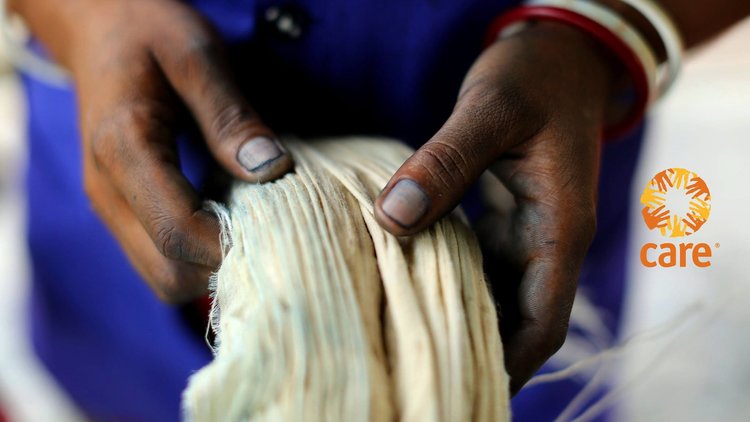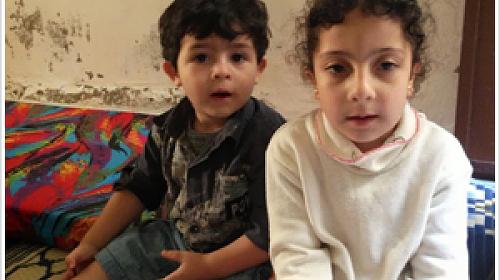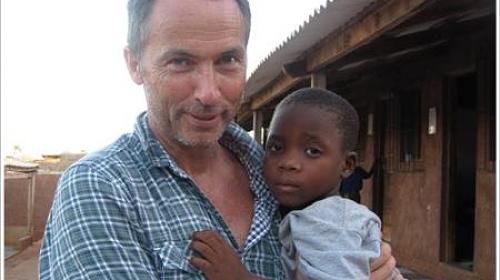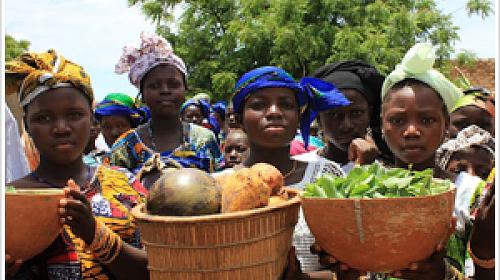
The National Museum of Women in the Arts unveiled handmade Living Blue scarves yesterday at its renowned Museum Shop in time for the holidays with a reception celebrating the CARE LIVING BLUE project of women artisans from Bangladesh, demonstrating how art made by women can be a catalyst to lift entire communities and regions out of poverty.
Founded by CARE and co-owned by the artisans, CARE LIVING BLUE has produced scarves and apparel for LVMH, Galeries Lafayette, and top designers working with local artisans, and for the first time will now be featured in the National Museum of Women in the Arts Museum Shop.
Bangladesh is ranked in the among the poorest countries in the world by the World Bank – with per capita income ranking 149 out of 198 countries. A recent study showed that women’s wages are significantly lower than men’s wages for the same job in Bangladesh, with women being paid only 25-40 percent of what men earn.
LIVING BLUE is a catalyst to improve conditions for women. It is also a new chapter in what once was a dark story. In the mid-1800s in the land then known as Bengal, Indigo cultivation and extraction was associated with exploitation. With the rebellion of 1859-1860 and crop failures that year, production collapsed. Nearly 15 million people died of starvation. Later, natural Indigo virtually ceased to be.
But the Indigo plant survived, and now, local farmers grow it as a rotation crop that adds nitrates and nutrients to the soil. It is grown on depleted land to replenish farmland for food cultivation.
The Indigo initiative launched by CARE LIVING BLUE has created numerous vocations and jobs — plant harvesters, Indigodye extractors and manufacturers, dyers, shibori and khetaartisans -- creating a foundation for small enterprises, textile-related manufacturing and regional economic development. In this social enterprise, the monetary benefits go to local families who can then afford medical care, education, better nutrition and a higher standard of living, enabling families exit the cycle of poverty.
The project has increased wages, food and nutrition security and health for more than 7500 families in 121 rural communities across Bangladesh.
Seele Magazine had a chat with Anowarul Haq, CARE Director for the Extreme Rural Poverty Program in Dhaka, Bangladesh.
Anowarul Haq: Northern Bangladesh where Living Blue is operating is still largely an agrarian society, with little alternative sources of income available to women besides seasonal agricultural work. Women with Living Blue can earn $4 a day, and spend this income in their family. Our analysis shows that they spend the money mainly for sending children to school, purchasing nutritional foods, building assets by investing in livestock, buying plots of land and even investing in their husbands’ trades. And they save for coping with future shocks and stresses.
AH: Before Living Blue, most women artisans never worked outside of the home or earned independent income. So CARE has worked for a decade with husbands, fathers and sons in the families since the inception of Living Blue to build support for women working.
The enterprise won’t be successful if men are not supportive. Over time, as we have facilitated women working, sometimes alongside men, the women gained respect in their own families by bringing in income and contributing to their families’ overall well-being. We saw something interesting: as women earned steady income through Living Blue, other family members including the husbands started helping with daily chores together to reduce the burden on their wives working outside the home.
Husbands now consider women’s involvement with Living Blue as “dignified.” To get to this point has been a journey. .
AH: CARE has worked with communities in Bangladesh since 1949 to abolish hunger and malnutrition and to build resilience to climate change and natural disasters -- by empowering women.
Today one in every five people in Bangladesh has been involved in a CARE project. As it happens, Living Blue actually grew out of a traditional development project and blossomed naturally into a social enterprise when the potential and abilities of the local artisans became clear.
At CARE we are committed to partnership. From the start, we ensured the workers themselves were owners of their enterprise -- a step not many social businesses have taken, but we felt was critical.
AH: Absolutely! You can support the artisans of Living Blue by buying our scarves and sharing our story with your family and friends. At present, Living Blue does not have an online shop, but you can explore www.livingbluebd.com and order your item by contacting us.
If you wish your favorite store carried Living Blue scarves and quilts, please tell them so! We are happy to tell them more, but you as the customer are the most powerful. If you represent a retail brand or boutique shop, we would love to explore how we might collaborate on a special collection as we have for Galeries Lafayette and others.
We are a growing brand that represents the best of Bangladesh while empowering the most vulnerable. Already more than 3,000 artisans, workers and indigo producers are benefiting from their participation, but we know we can reach more. We are seeking philanthropic investment to expand the business. If you'd like to know more about making a tax-deductible investment in Living Blue, please contact Rachel Mlinarchik (rachel.mlinarchik@care.org) at CARE's D.C. office-- we thank you in advance for your interest.
Founded in 1945, CARE is a leading humanitarian organization fighting global poverty. CARE places special focus on working alongside poor girls and women because, equipped with the proper resources, they have the power to lift whole families and entire communities out of poverty. Last year, CARE worked in 94 countries and reached more than 80 million people around the world. To learn more, please visit our site here.
The National Museum of Women in the Arts (NMWA) is the only major museum in the world solely dedicated to championing women through the arts. NMWA advocates for better representation of women artists and serves as a vital center for thought leadership, community engagement, and social change.



